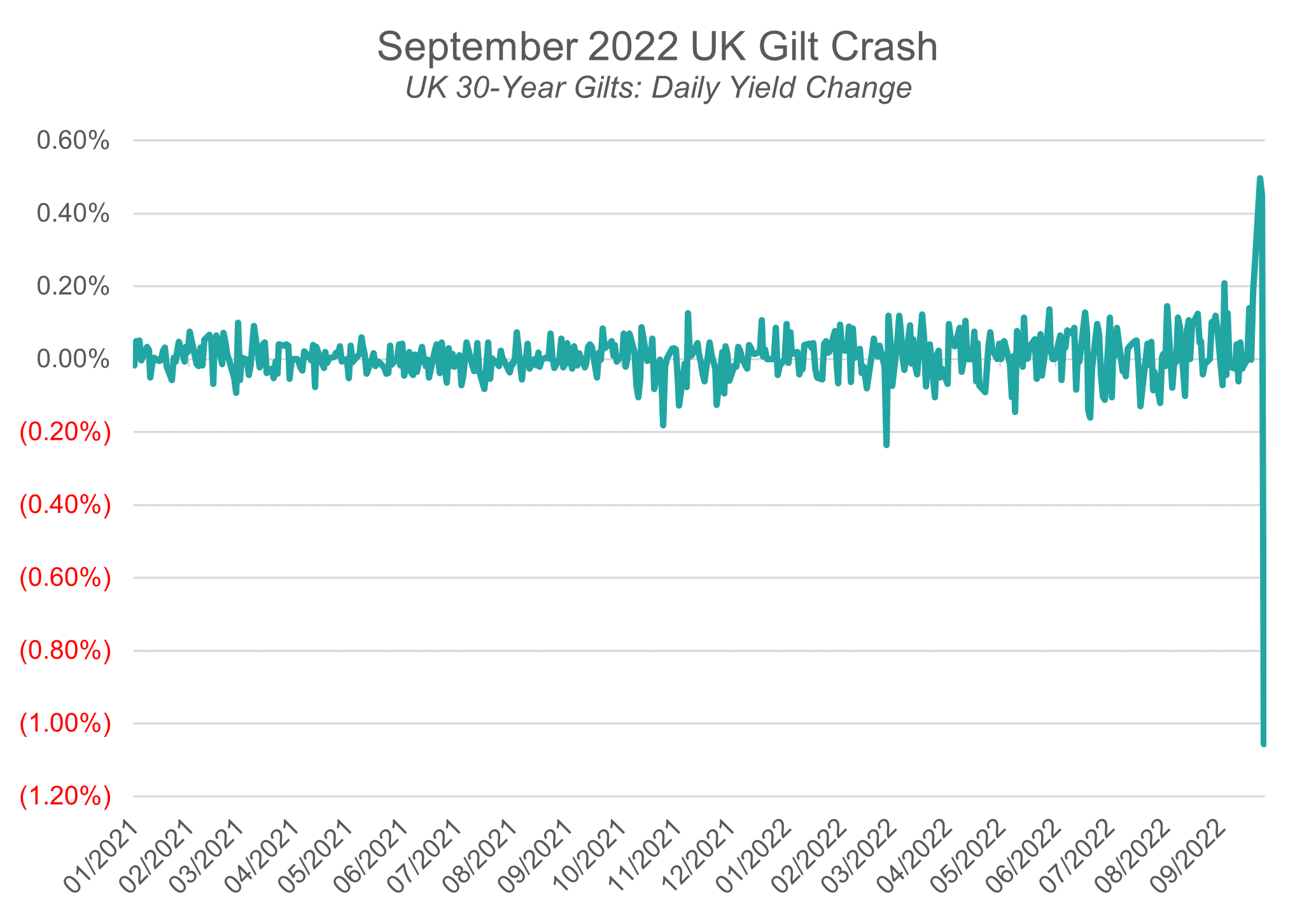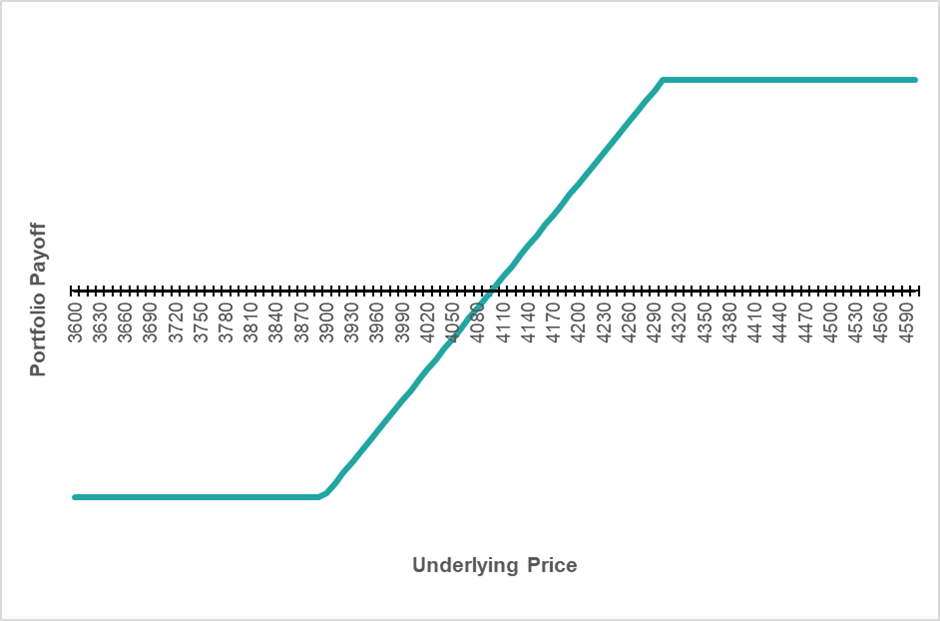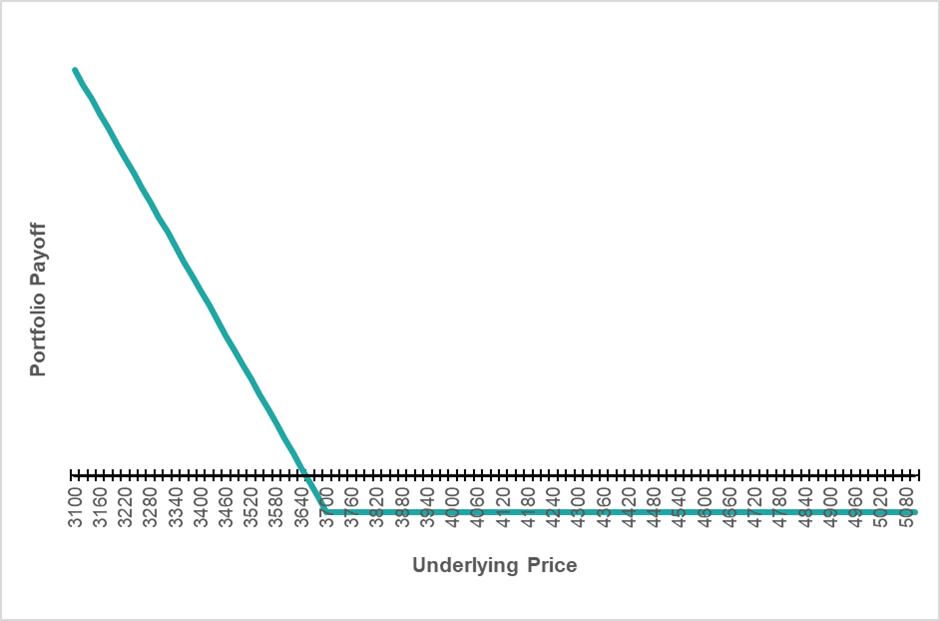Tail Risks & Multi-Asset Portfolios
Tail risk, the theory:
“Tail risk is a risk to the portfolio which would eventuate if an asset (or assets) move more than three standard deviations from its long-term average distribution”
Tail
risk, the
practical:

Whether someone is running a multi-strategy hedge fund, a managed account portfolio or simply their SMSF, any manager in a multi-asset context faces a wide universe of possible tail risks. The more assets/markets you add into your strategy, the more you expose yourself to shocks – this is the nature of capital markets.
The (admittedly extreme) example of the move in UK 30-year government bonds in September 2022 was 17 standard deviations below the average daily change. The probability of that move occurring is less than 0.000003%, but if you were long those bonds at the time, your bond position just moved over 20% against you in a day.
If you were using a short bond position to balance some kind of equity exposure, then your entire portfolio strategy would have been in jeopardy if those tail risks were not managed appropriately.
Which begs the question: how can investors identify and manage these tail risks, regardless of their size and sophistication?
The Environment for Tail Risks
By the very nature of being a rare event, tail risks are infamously hard to predict – this goes back to the old adage of “the stock market has predicted nine of the last five recessions”, where even the best models may throw out false positives and false negatives in extreme environments.
Before going any further, it’s worth noting that tail-risk can happen in both directions of asset prices: negative, and positive.Although generally most investors would be happy about a positive shock coming along and boosting portfolio returns, an underappreciated driver of markets is career risk. For example: the manager of a multi-billion-dollar pension fund, who is underinvested against their benchmark, might see the market rallying away from them, and to avoid underperformance they have to then aggressively chase market beta to catch up. This “hedging of right-tail risk” likely contributed to the strong returns US equities saw in January this year.
In the past few years alone, we’ve had a “once in 100 years” pandemic event, high inflation for the first time in most investor’s careers, a hot war break out in Europe, a European energy crisis and (on the right-tail risk side of things) a sudden re-opening of the Chinese economy. Very few could say they called all of these risks perfectly, and many who do were permanent bulls/bears applying the “broken clock is right twice a day” method of forecasting.
With that being said, there are methods for identifying environments of heightened tail risks.
-
Valuation: heightened valuations increase the risk of volatility, mean reversion or wide spreads in assets – all of which are vulnerable to shocks due to the ‘blue sky’ expectations built into the price
-
Leverage: highly leveraged markets introduce dynamics where a slightly larger than expected change in price can quickly cascade into tail-risk events
-
Market sentiment: frothy or overly optimistic market sentiment can lead to investors ignoring risks or compounding problems by chasing the price up (see: reflexivity)
-
Geopolitical tensions: an uncertain or aggressive political environment heightens the probability that a shock beyond the control of asset markets takes place (e.g. Russia/Ukraine)
-
Implied volatility indexes can provide valuable clues to the riskiness of the environment (VIX, MOVE)
- Statistical methods: various quantitative methods exist to model volatility of assets and make conjectures about the level of tail-risk (for example: stochastic volatility, Value-at-Risk and EGARCH)
Protecting Against Tail Risks
As a former employer of mine was fond of saying, “there’s no such thing as a free lunch” – and this rings true for portfolio protection as much as it does for lunches.
There is always some form of cost associated with protecting against tail risks, whether it be premiums paid for options, basis risk (the cost associated with not hedging perfectly), management fees paid to alternatives strategies or just maintaining discipline in a strategy which is best suited to handle volatility.
Most investors have to
think about this cost like the cost of insurance: you want to size the cost
appropriately that it won’t seriously hurt performance if nothing ever happens,
but the payout should be large enough that it acts as a sufficient lifeline in
a crisis. You don’t want to pay $100,000 per year in fire insurance premium on
a $500,000 house – but you don’t want the payout to be $50,000 in the event the
place burns down.
Here is a non-exhaustive lists of methods different investors use to hedge
tail risks:
Institutional:
A collar option strategy protects a portfolio by simultaneously selling a call and buying a put option – the effect is that you give away meaningful upside, but limit your downside. This might be used where you don’t want to sell out of your portfolio, but feel that a meaningful correction is right around the corner. Done right, this should cost very little for a large investor.

Another way of using options might be buying an out-of-the-money (OOM) put, without needing to have any underlying exposure. The idea of buying an OOM put is that it’s very cheap, so if you are only mildly confident that a tail-risk might occur in markets, it won’t cost an arm and a leg to express this view.

Rather than buying puts directly, you could also employ a put-option replication strategy, which creates the same risk/reward as buying a put using a blend of financial instruments (there are many hedge overlay funds and ETFs which employ this strategy).
(Side note: we’ve eschewed
much of the complexity around option premiums, pricing and sizing, which goes
beyond the scope of this note)
Finally, you might not have an idea where the market will go, but believe an
event will occur which will drastically increase volatility – there’s a method
to hedge that too!
Many multi-asset strategies will buy VIX futures, which are contracts which
express a view about where the level of the CBOE Volatility Index will be at
some point in time. This is very much an exercise in picking market
tops/bottoms, however in a managed strategy it has been historically effective
at guarding from tail risks.
Broader Methods:
Of course, not all (or even most) investors can access strategies using derivatives directly, and yet we certainly feel at Innova we have a vast toolbelt of methods to protect clients against tail-risks – and individual investors can utilise similar methods.
Trend following strategies had a phenomenal year last year, putting them back on the radar of many investors who had become unfamiliar with this quantitative strategy.
There is a large body of evidence, in both academia and many investors’ empirical experience, that trend following can be an effective hedge to a portfolio during periods of market sell-downs. Better yet, unlike certain other “volatility” strategies, trend following can often track sideways for years until it kicks in for a large gain, making it quite cheap insurance. Even better yet, there are multiple trend following strategies available to Australian investors today, making it a convenient inclusion to a portfolio.
Diversification is and always will be a tried-and-true method for reducing many forms of risk within a portfolio. This might sound contradictory to the start of this note, where we said adding assets increases your exposure to tail hedges – however intelligent diversification using a disciplined process can often buffer an overall portfolio from a shock within one market, or even an entire asset class.
The diversification approach works particularly well when paired with valuation discipline: mathematically, assets with stretched valuations tend to be more volatile and exposed to exogenous shocks more than fair-value or cheap assets – there are more expectations priced in, more duration, and therefore more sensitivity to tail risks. Maintaining a well-diversified portfolio which identifies under-priced assets, with asymmetric return profiles, is one of the most robust and consistent methods an investor can implement for protection against tail risks.
Chasing Your Own Tail
Regardless of the size or complexity of an investor’s situation, to be unaware of environments where tail risks might permeate and how to prepare for them is to court potential ruin.
By their nature, a significant shock is not something we can plan for to the day or something we should build an entire portfolio around defending, but it is one of the undisputable risks of being a multi-asset investor: add more assets, you add more markets where tails might appear.
Whilst many sophisticated methods exist to identify and hedge these risks, some of the most prudent investing adages around staying diversified, sizing your positions and not chasing expensive trends will serve anybody well in this scenario. Avoiding large drawdowns is a key element of long-term successful investing at any level, and investors would do well to not chase their tail instead of being disciplined with what they already hold.
Never miss an update
Enjoy this wire? Hit the 'like' button to let us know. Stay up to date with my content by hitting the 'follow' button below and you'll be notified every time I post a wire.
Not already a Livewire member? Sign up today to get free access to investment ideas and strategies from Australia’s leading investors.
5 topics

